I can’t think of any weapon that conveys the zeitgeist of 80s action movies more than the HK MP5. Half of Dutch Schaefer’s team carried MP5 lookalikes, as did Riggs (Lethal Weapon), Nada (They Live), and eventually, John McClane (Die Hard). Most of the Navy SEALs in the movie of that name carry MP5s, too, although that particular flick didn’t come out until 1990.
The Heckler & Koch Maschinenpistole 5 and its variants are iconic. Its imitators and clones remain surprisingly popular even today, even with a world of pistol caliber carbines, CZ Scorpions, MCXs, and SOCOM PDW solicitation contenders to choose from instead.
Why? What gives?
⚠️ I’m not a firearms historian at all. Never even played one on TV. If you have some leads I can use to expand this article, hit me up in the comments! DR
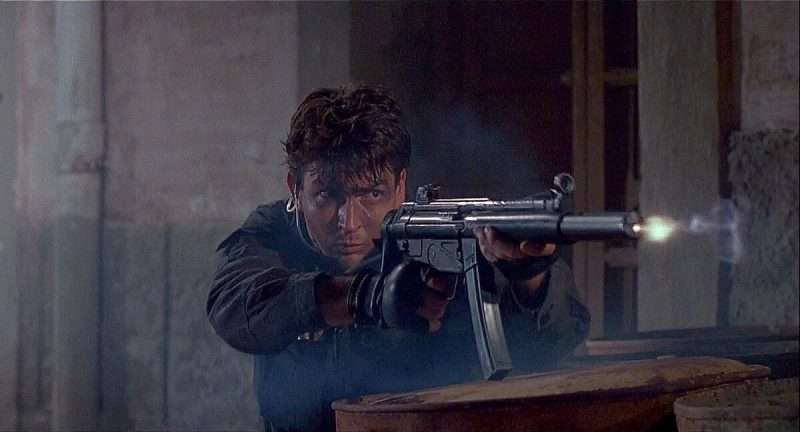
HK MP5 in the movies: LTJG Dale Hawkins (Charlie Sheen) shooting at terrorists with an H&K MP5SD3.
HK MP5 Background
Although the MP5 was designed in the mid-1960s, it took the live coverage of an international incident to prompt a public debut on the world stage. The weapon was a decade and a half old when Khuzestani separatists took over the Iranian Embassy at Prince’s Gate in London in 1980. Britain’s response to the Iranian Embassy Siege, which ended in a special operations hostage rescue raid called “Operation Nimrod,” was broadcast internationally. The most iconic scenes of Operation Nimrod included operators of the 22nd Special Air Service Regiment (British SAS). Their well-tricked-out (for the time) MP5s quickly captured the world’s attention.
The following two decades saw the weapon proliferate across counter-terrorism (CT) and special operations forces (SOF) units all over the Western and Third worlds.
Scores of different MP5 models, derivatives, clones, and copies now exist. Most are originally built by Heckler & Koch or licensed by them and chambered in 9x19mm, but some are neither. Those used by security forces are often select-fire, but semi-automatic versions exist.
Although the MP5 is now a dated design, it remains in common use. It’s still popular in movie use, frequently appears in video games like Modern Warfare, and remains in service in numerous military, law enforcement, and security services.
According to the Bundeswehr Verification Center (Zentrum für Verifikationsaufgaben der Bundeswehr) and other sources, MP5s are used in nearly a hundred different countries. They can be found from Afghanistan to Zambia, including the United States and most, if not all, NATO countries. This includes licensed and unlicensed versions of the weapon and government, non-government, and non-state users.
The Heckler & Koch MP5 submachine gun is probably the most recognizable post-WWII era subgun in the world – although the Uzi could prob’ly argue the point.
Intended Use
Most versions of the MP5 are utilized by military units, law enforcement agencies, intelligence/counter-intelligence units, and security force formations. Although primarily associated with special operations forces (SOF, “special forces”), SWAT teams, and other specialized elements, the weapon can also be found in more “mundane” places like patrol units and the gun safes of responsible citizens. In its early years, the firearm’s compact size, accuracy potential, and smooth shooting made it more suitable for close quarters and confined space use than the typical assault rifle of the time.
This isn’t just room clearing and CQB/CQC (Close Quarters Battle/ Close Quarters Combat) situations. This might also include undercover/concealed work, the ability to deploy and manipulate the weapon in a vehicle efficiently, and use in other environments.
Advances in ammo ballistics, technology, and experience-based doctrinal changes (including, to some extent, the North Hollywood shootout in LA) have pushed a transition from the MP5 family to that of the M4. Some organizations have shifted to the UMP45 (a variant of the MP5) and other (no so) long guns, like the Scorpion, Banshee, and MCX.
MP5 History
Heckler & Koch, the MP5’s designers, was founded in 1948 by former Mauser Werke employees Edmond Heckler, Alex Seidel, and Theodore Koch. Koch is pronounced like coke, though you’ll hear many people say it like cock. Heckler was a former Mauser plant manager, Koch a former engineer, and Seidel, an industrial mechanic. Because of post-war restrictions on German production of weaponry and ammunition, the company originally manufactured machine tool gauges, sewing machine parts, and related products. It was about a decade later, when those restrictions were removed, that the company moved into firearm development.
(You recognized Mauser, right?)
The German submachine gun was originally labeled the HK54. Its earliest progenitor was the M.Kb. Gerät 06, which no one but the cognoscenti has heard of, and the StG 45, which is only marginally better known. Both those weapons utilize a roller lock operating system that would later be incorporated into the much-better-known G3 rifle. The HK G3 battle rifle, for all its size, is just one generation older than the original MP5 and had much to do with that weapon’s inspiration.
The weapon was originally intended for sale to West German (and possibly other, non-Soviet Bloc) police forces. It began in 1964 as part of “Project 64”.
Think about this…the MP5 was developed closer to the end of WWII than the iPhone 14’s release was to the 9/11 attacks.
Project 64 began the development of a family of four kinds of small arms. Each group centered around a different caliber, but all weapons were predicated on the G3’s design and operating system.
Those calibers were:
1. 7.62×51 NATO
2. 7.62×39 M43
3. 5.56x45mm NATO
4. 9x19mm Luger
The MP5, in its incarnation as the HK54, was in the latter group (Group 4).
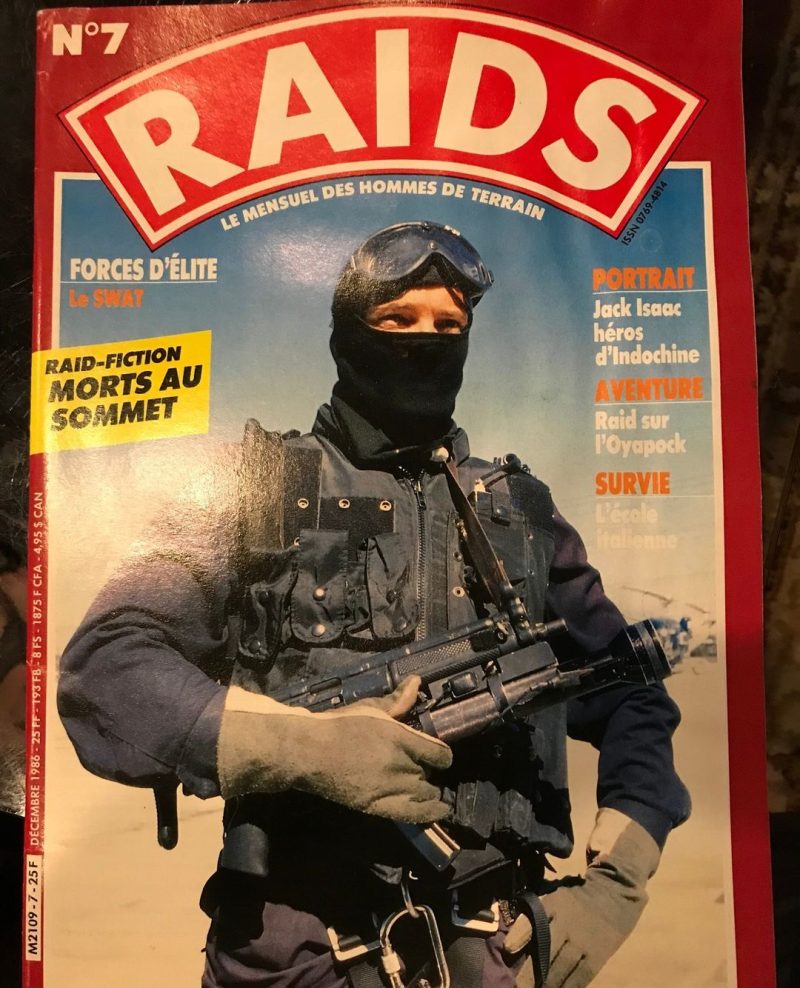
Scott Reitz (aka “Uncle Scotty”), LAPD SIS and SWAT, with a (contemporarily) tricked-out MP5 in the French magazine RAIDS. From an article about CT preparations for the 1984 Olympics. Look at that WMLs! That’s some old-school MP5 light forend action there (probably a Streamlight SL-20 in a Laser Products mount, but possibly something else.
The MP5 Family
There are numerous versions of the MP5, with an even larger number of variants if you factor in niche-specific accessories. Barrel length varies from extremely short out to carbine length; pistol grips vary, as do sights, stocks, vertical foregrips, barrel threading (if any), and other integral features. This is only a basic overview, provided here mostly thanks to Leroy Thompson’s Osprey book about the MP5.
HK54: The original version of what would become the MP5, produced by HK prior to 1966.
MP5A1: The first version of the MP5, with no stock and the “S–E–F” selector.
MP5A2: The version that would become the standard, with fixed stock and “S–E–F” selector.
MP5A3: With retractable stock and “S–E–F” selector.
MP5A4: With fixed stock and three-shot-burst trigger group. MP5A5: With retractable stock and three-shot-burst trigger group.
MP5-SFA2: Single Fire (semi-auto) version with fixed stock.
MP5-SFA3: Single Fire (semi-auto) version with retractable stock.
MP5-SFA4: Fixed stock with a straight pistol grip and an ambidextrous four-position trigger group with bullet pictograms instead of lettering.
MP5A4 (fixed stock) and MP5A5 (sliding stock) models.
MP5-N: US Navy model with “Navy” trigger group, retractable stock with rubber butt pad, and three-lug barrel threaded for a suppressor.
MP5F: Version for the French armed forces, featuring ambidextrous sling mounts, and beefed up internally to handle high-pressure ammunition.
MP5K: Compact version of the MP5, with or without folding stock, and “S–E–F” trigger group.
MP5KA1: Compact version with fixed rear sight and “S–E–F” trigger group.
MP5KA4: Compact version with the three-round-burst trigger group.
MP5KA5: As with the MP5KA1; fixed rear sight, but with the three-round-burst trigger group.
The Punisher’s MP5s
“Here’s a pair of funny guns … you could easily mistake one for the other and that could be a big mistake, indeed. Heckler & Koch has been famous for a sleek line of little black guns, but the MP5lK is pretty famous as the representative gun of police and government agencies around the world.
But it is a submachine gun with a very nice feel; it’s short and highly maneuverable … ifs so small that with the 15- round magazine, it can be carried under the shoulder. The lower of these two guns is the more recent SP89 pistol. It is semiautomatic only. But with the duel magazine clamp and thus, two30-round magazines … either gun can be an awesome opponent.”
Even though either gun can accommodate the vertical grip attachment, I prefer the smooth barrel shroud, which just feels better. As for the stool, well, I was breaking in these two weapons with live fire and I got tired from standing so long – dependable guns, these, not a bum cycle in the run of about 3,000 rounds.”
MP5K and SP89 – Frank “Punisher” Castle style, the redoubtable Eliot R Brown
MP5K-N: US Navy version of the compact model with three-lug barrel threaded for suppressors and US Navy trigger group.
MP5K-PDW: “Personal Defense Weapon” (PDW) with characteristics of the MP5K-N but with a folding stock.
MP5SD1: Integrally suppressed (though detachable) version with no stock but instead an end cap, and “S–E–F” trigger group. MP5 SD versions use a lightened bolt to reduce mechanical noise/
MP5SD2: Integrally suppressed version with fixed stock and “S–E–F” trigger group.
MP5SD3: Integrally suppressed version with retractable stock and “S–E–F” trigger group.
MP5SD4: Integrally suppressed version with no stock but instead an end cap, and three-round-burst trigger group.
MP5SD5: Integrally suppressed version with fixed stock and three-round-burst trigger group.
MP5SD6: Integrally suppressed version with retractable stock and three-shot-burst trigger group.
MP5SD-N1: Version with retractable stock, Navy trigger group in place of original SEF, equipped with a Knight’s Armament Company (KAC) suppressor intended for use with subsonic ammunition. This model also has ambi controls, straight pistol grip, and a pictogram marked fire control group. Originally it utilized a four-position selector (safe, semi, 3-round burst, fully automatic); later replaced by a 3-position ambi selector).
MP5SD-N2: Version with fixed stock, Navy trigger group, and fitted with a KAC stainless-steel suppressor.
MP5/10: Version in 10mm caliber in various stock and trigger-group configurations, principally for the FBI.
MP5/40: Version in .40 Smith & Wesson in various stock and trigger-group configurations.
MP5 MLI (Mid Life Improvement): Released in 2013 for “enhanced functionality,” fitted with tri-rail foregrip, QD optic mount, MP5F stock, and other, more modern accouterment.
HK94: A semi-auto version of the MP5.
SP89: A semi-auto version of the MP5K produced for US civilian markets without a stock (or brace, when that was significant), so it qualified for sale as a pistol.
Other “aftermarket” styles exist, including the Zenith Z 5RS, Century Arms AP5, Quarter Circle 10 YKMF-5 (which is MP5~ish), and others.
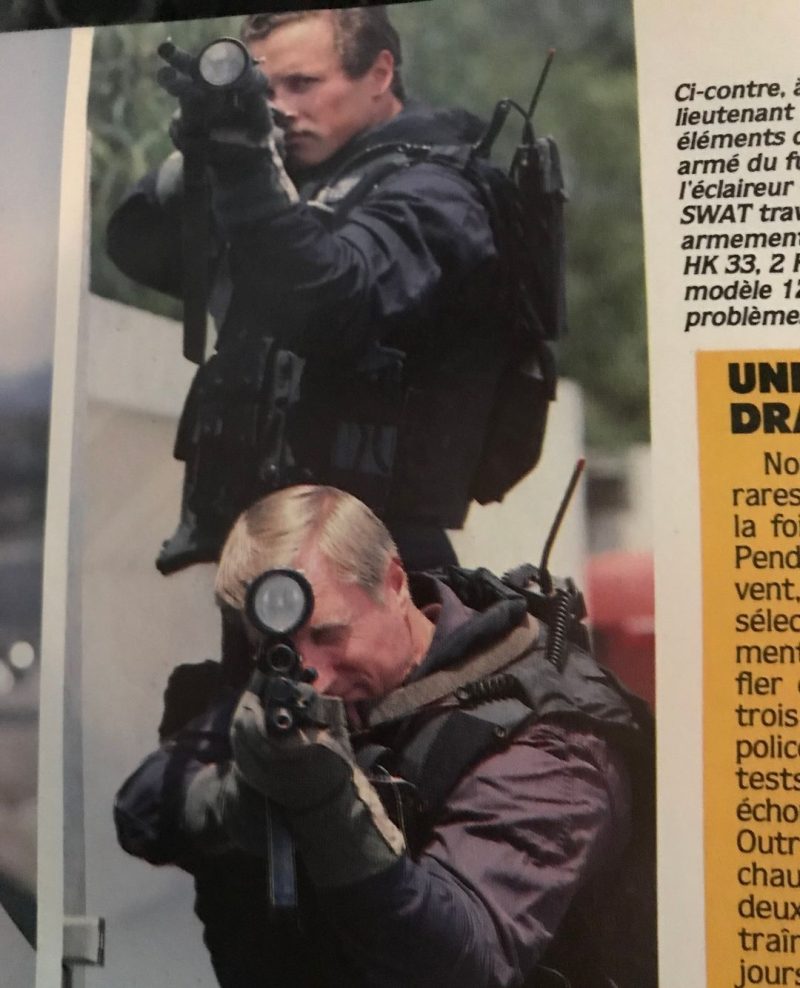
MP5 weapon light mounted high on HK Claw Mount (front); shotgun light in a 9 o’clock mount (back). Posed images of LAPD SWAT officers in the French magazine RAIDS covering counter-terror/security preparations at the 1984 Olympics.
HK MP5 Trivia
The SAS did not originally use the MP5. Their Special Projects Team initially preferred the Ingram MAC-10, but after joint training with GSG9 decided to switch.
MP5 mags don’t allow a last-round bolt hold open. When you run the magazine dry, the bolt drops forward and closes.
MP5 Specs and Features
It would take a lot of space to run these down, but the basics are as follows:
Caliber: Predominantly 9x19mm. .40 S&W and 10mm versions exist
Operation: closed bolt, recoil-operated
Bolt system: moveable roller-delayed blowback
Modes of fire: Semi-auto and select-fire: 2-round burst (not binary trigger style), 3-round burst, and sustained fire (full auto)
Barrel profile/Twist: 6 grooves, right-hand twist
Charging: left side non-reciprocating cocking handle (charging handle) on the forearm
Ejection: right side
Feeding: Detachable box magazine
Magazine capacity: 15- and 30-rounds. (Many memoirs and articles say 20, but those are incorrect).
READ: MP5 vs MPX
Roller Delayed Blowback
Unlike many (maybe most) other subguns and numerous PDWs, the MP5 fires from the closed bolt position and utilizes the roller-delayed blowback system.
“Closed bolt position” means the bolt is forward and a round is chambered before the shooter pulls the trigger. This eliminates the shifting of the bolt’s mass, which can impact accuracy, caused when an open bolt weapon begins to cycle. Only the hammer and firing pin of an MP5 move when the weapon is fired. Open bolt submachine guns like the M3 “Grease Gun,” MAC-10, Sten gun, Uzi, and others often have a greater cyclic rate of fire than closed bolt guns but also have a latency between trigger pull and the weapon firing. (You can see this more overtly in something like the M60 machine gun than a MAC-11, but it’s there.)
A direct blowback design, common in AR9 and similar Pistol Caliber Carbines (PCCs), utilizes the gas from a fired cartridge to propel a bullet down the barrel while simultaneously pushing the bolt back to cycle the weapon. Though simple, this system requires springs and heavier bolts to function properly.
By contrast, the roller-delayed blowback system uses rollers built into the bolt. When the gas from a fired cartridge begins to expand and push a bullet down the barrel, these rollers prevent an immediate release in the rearward movement of the bolt. That slight delay lets the bullet leave the barrel before another is cycled into the breach. This eliminates the need for heavy bolts and springs, but it’s more complicated (and costly) to produce.
MP5 Cycle of Operations
1. Feeding
2. Chambering
3. Locking
4. Firing
5. Unlocking
6. Extracting
7. Ejecting
8. Cocking
Hell, they’re so easy to shoot Dillon’s arm kept going even after the Predator shot it off Dillon’s shoulder.
Function Checking an MP5
Once the magazine is removed and the weapon is visually and physically cleared, follow these steps:
1. With the weapon pointed in a safe direction (or in a clearing barrel), pull the cocking handle to the rear and release it. Ensure the selector lever is on SAFE and pull the trigger. The hammer should not fall.
2. Place the selector lever on SEMI. Pull the trigger and hold it to the rear. The hammer should fall.
3. Pull cocking handle to the rear and release. Release the trigger, listen for the reset, then pull again. The hammer should fall.
4. Pull the charging handle to the rear and release. Place the selector switch on AUTO (if function-checking a select-fire weapon) is
D. Pull cocking handle to the rear and release. Place the selector lever on AUTO. Pull the trigger and hold it to the rear. The hammer should fall.
E. Pull charging handle to the rear several times and release. Release the trigger and pull again. The hammer should not fall.
F. Pull cocking handle to the rear, release, and pull the trigger. The hammer should fall.
G. Pull cocking handle to the rear and release. Place the selector lever on SAFE.
MP5 History, Notable Dates
1964 Project 64 begins
1966 West German Bundespolizei adopts the weapon.
1970 MP5A2 and MP5A3 are introduced.
1972 Munich Olympics massacre at Olympic Village (German police there were armed with Walther MPLs, though MP5s were in use at the time). This led to the development of a counterterrorism unit.
1973 Grenzschutz-gruppe 9 (Border Police Group 9, GSG 9) established as part of the Bundesgrenzschutz; they use the SD MP5 variant in addition to the MP5A2 and MP5K.
1974 The MP5 SD, a suppressed version of MP5, introduced along with MP5A4 (fixed stock) and MP5A5 (sliding stock) models. (SD stands for Schalldämpfer, German for ‘sound suppressor’).
1976 The MP5K released.
C.1977 22 SAS adopts the MP5 in lieu of the Ingram Mac-10.
Also in 1977:
• The MP5 goes from using a double-column box magazine to the slightly curved, 15- and 30-round steel mags you’re familiar with today.
• London Metropolitan Police add select-fire MP5 subguns to the semi-auto versions already in their armories.
• GSG9 rescue passengers of Lufthansa aircraft; CT operators utilized predominantly handguns and MP5s; the first terrorist killed was reportedly a female hostile shot with an MP5, killing her instantly.
• 1978 Italy’s Carabinieri Special Intervention Group (Gruppo di Interveno Speciale, GIS) goes operational. They initially utilized the Beretta PM12 SMG but quickly added the MP5 to their TOE.
• 1980 Operation Nimrod, the rescue of hostages at the Iranian Embassy in London
• 1982 The FBI forms the Hostage Rescue Team after training with SFOD-D, the SAS, and other units.
• 1986 India stands up the NSG (National Security Guard, “Black Cats”), a CT unit. Commandos of this unit, MARCOS operators, and others were forced to clear nearly a thousand rooms during the attacks on the Taj Mahal Hotel and Oberoi Trident in Mumbai in 2008. Some of these operators reportedly used MP5 variants during that operation.
Also in 1986, the MP5-N (Navy) released
• 1993 Canada stands up Joint Task Force Two (JTF2); MP5 variants are a part of their possible loadout.
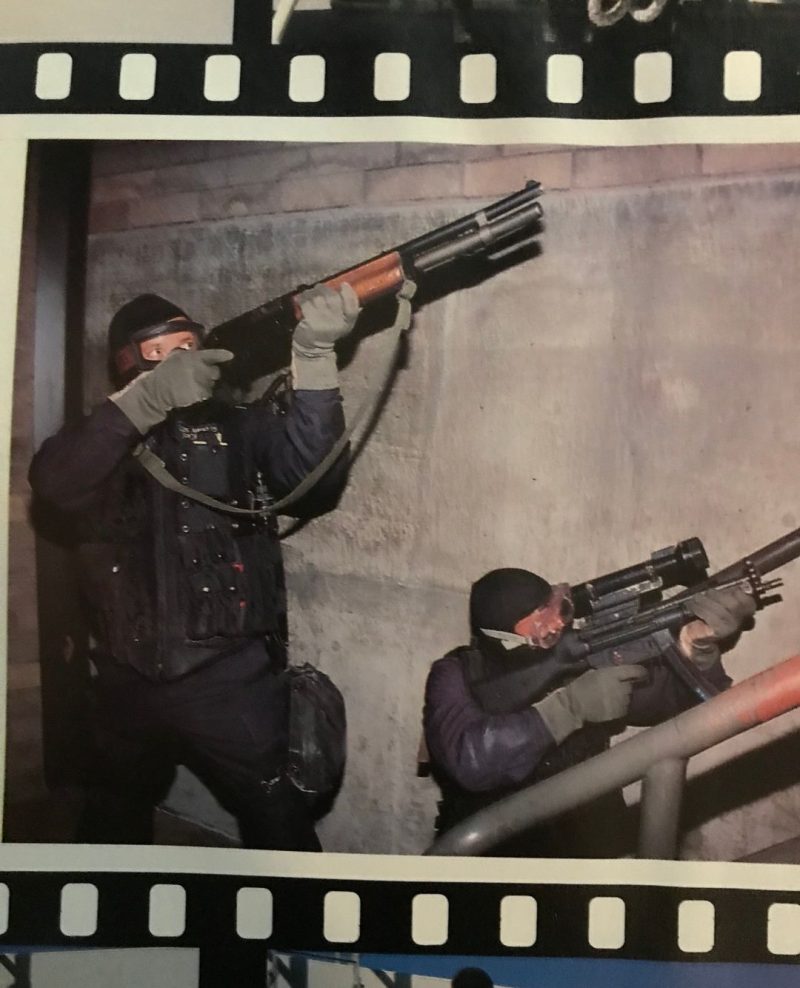
More venerable MP5 accessories. That MP5 light on top of the guy’s SMG to the right is often called a “SAS light” or, in the UK, a “Princes Gate torch.” It’s almost certainly mounted thereon an early HK claw mount. Many folks assumed WMLs like this (and their mounts) were from Maglite, but many were from a company called Laser Products, headquartered in Fountain Valley, CA. Laser Products is the name Surefire went by in its early years. Tape switches were used with some mounts, at least one version interfacing with the rechargeable battery of an early Streamlight flashlight (the first iteration of a Streamlight SL-20) via a Laser Products light mount for remote actuation. Those claw mounts look like they’d block the use of the sights, and contemporary observers (who didn’t have internet for research!) speculated operators used the light’s beam as a de facto aiming device. Actually, the HK claw mount was a tall, look-through contraption that allowed you to use the sights. (See also this POTD.)
Additional reading:
- Heckler & Koch on Wikipedia
- The Role of Subguns in LE
- Freedom of choice: M4/MP5
- Zentrum für Verifikationsaufgaben der Bundeswehr (ZVBw)
HK MP5 Pictures
A ~pseudo-gallery.
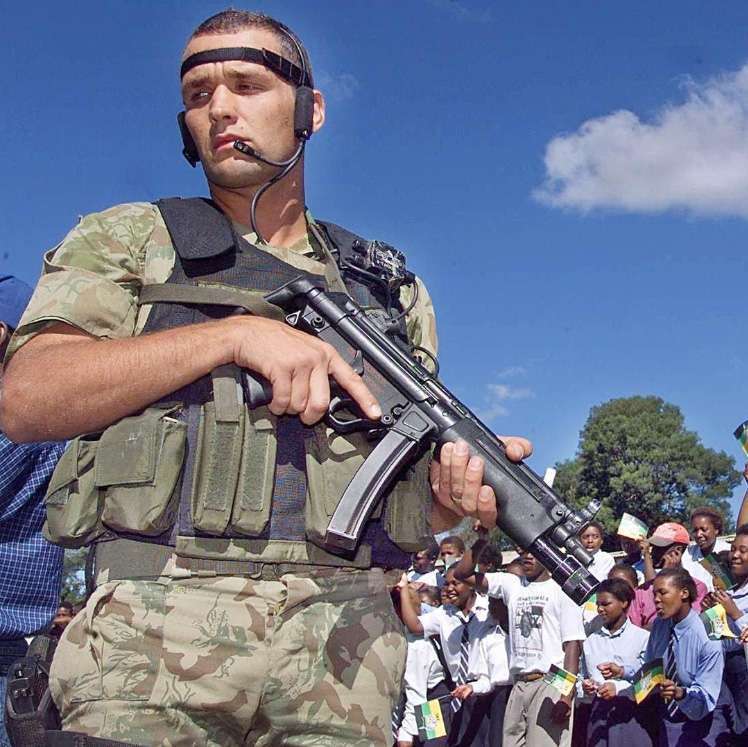
HK MP5 history: one of South Africa’s Recce Commandoes (SANDF SOF) with MP5 on security detail, reportedly Thabo Mbeki.
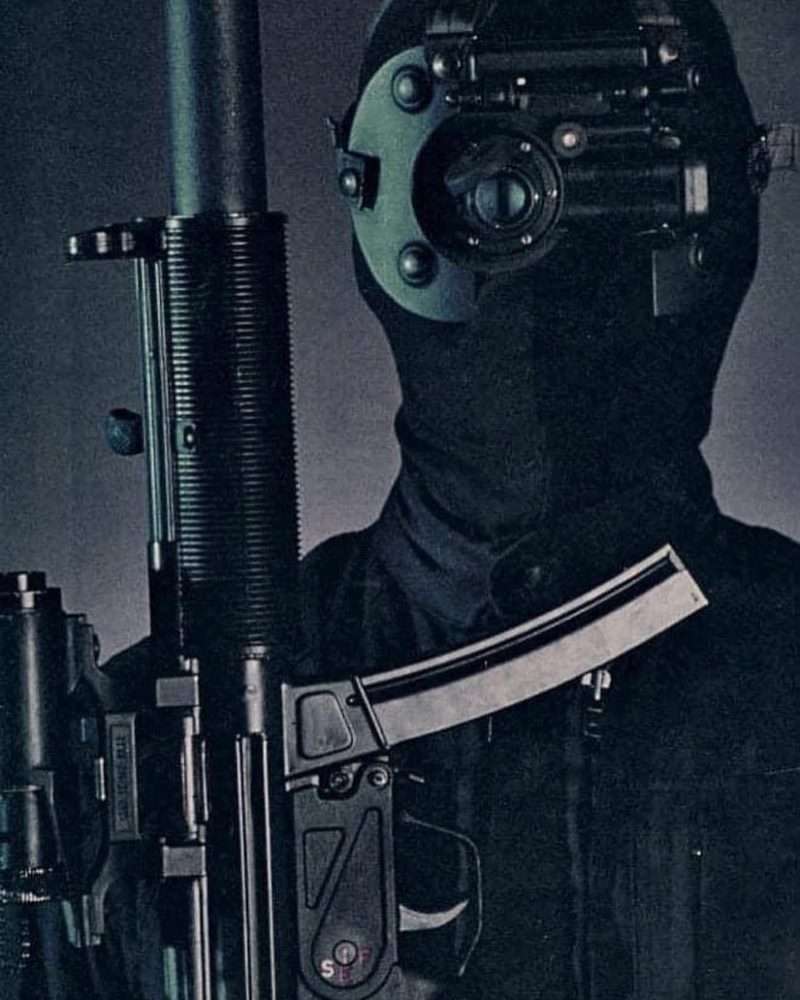
80s Vibes: a mid-80s poster featuring a suppressed MP5.
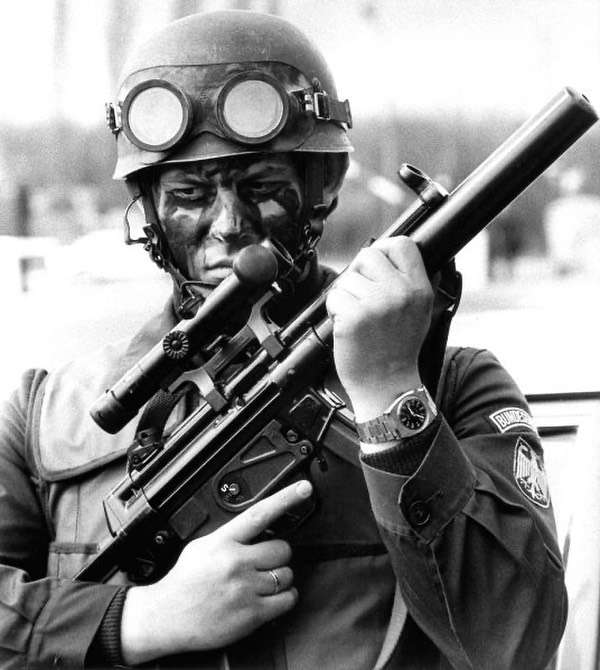
You may be old skool cool, but you prob’ly aren’t old skool GSG9 with MP5 cool. Check out those MP5 accessories and helmet kit!
Find what’s in stock, and where, and compare prices.
⚠️ Some hyperlinks in this article may contain affiliate links. If you use them to make a purchase, we will receive a small commission at no additional cost to you. It’s just one way to Back the Bang. #backthebang

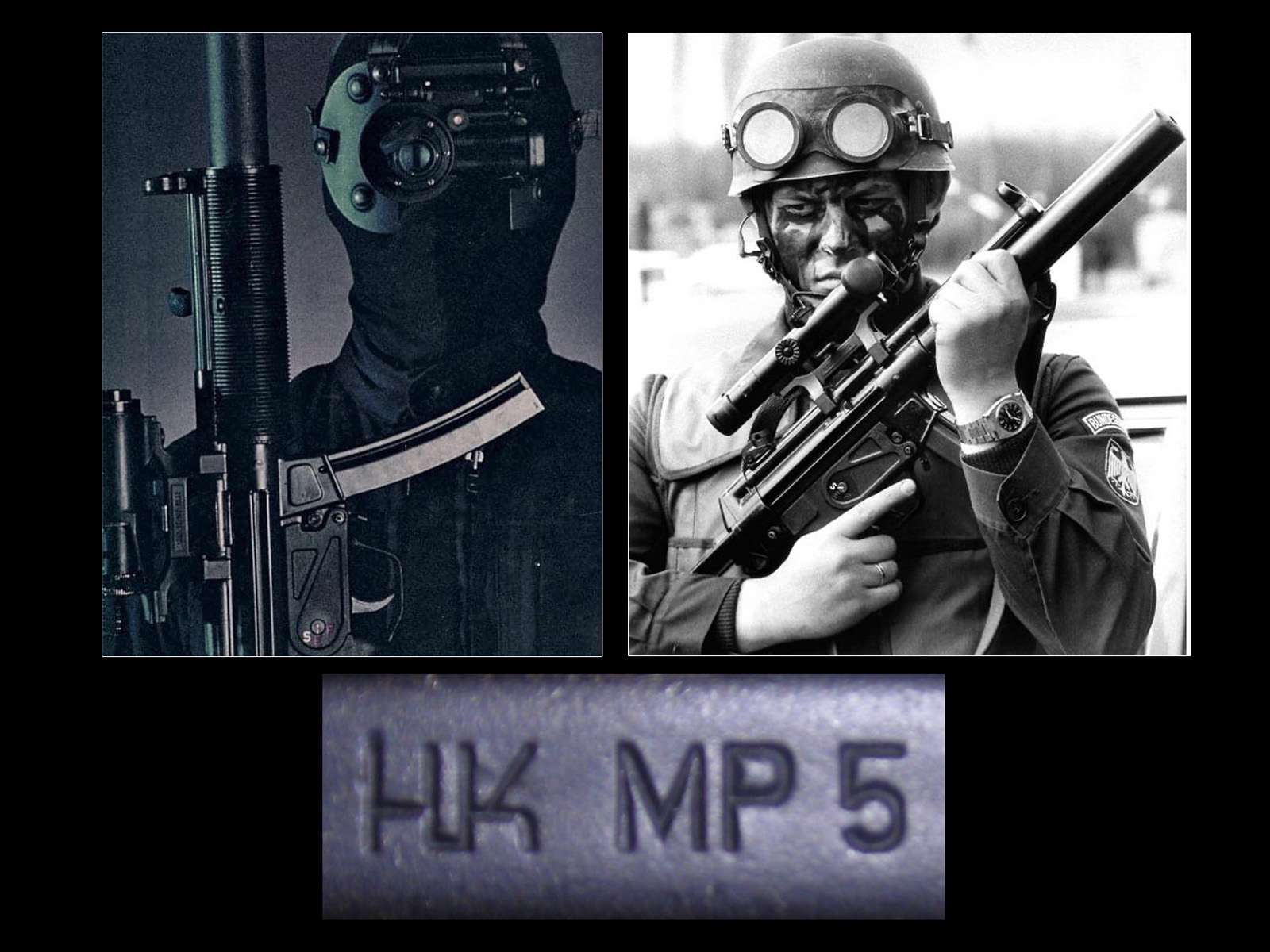
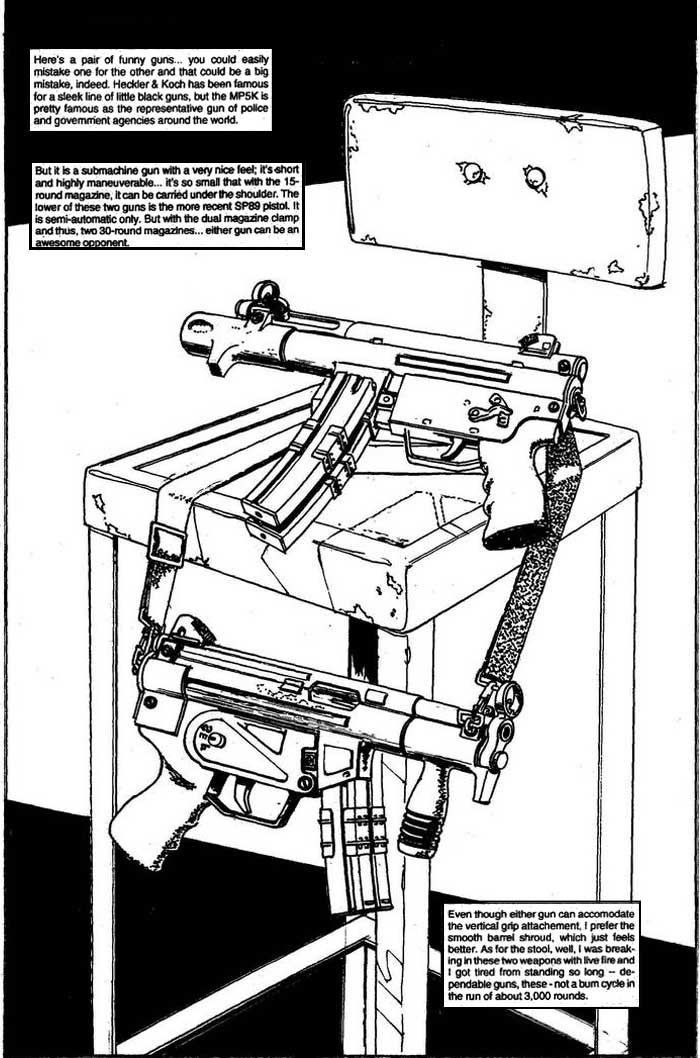

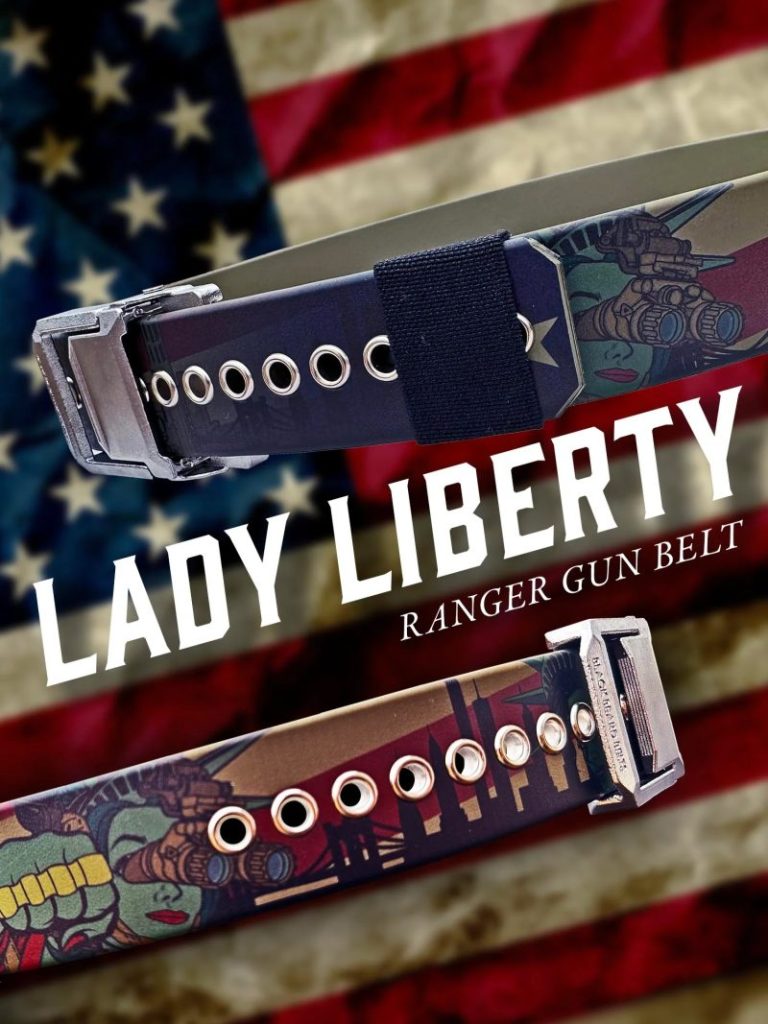
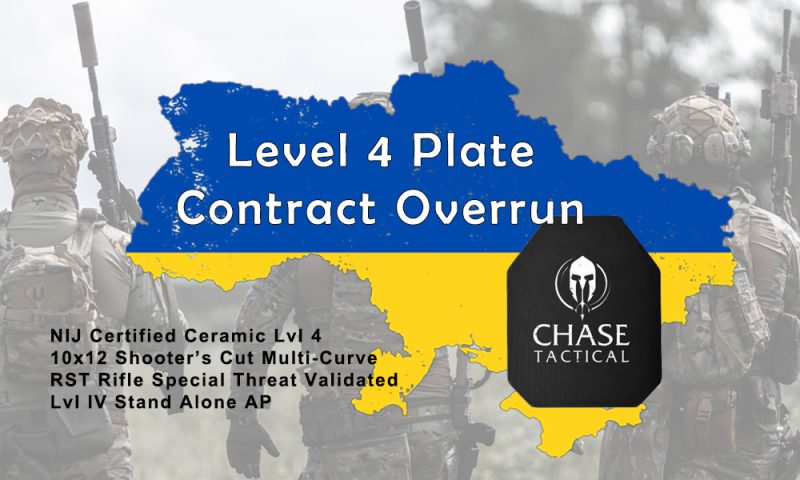



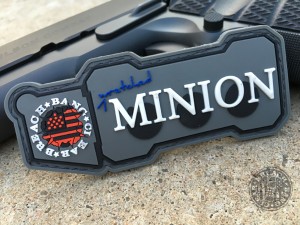
0 Comments